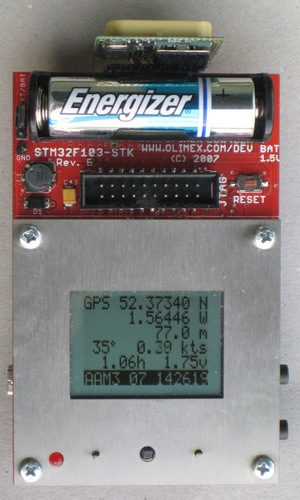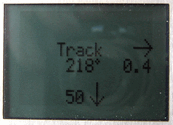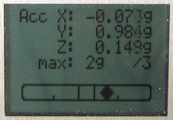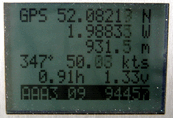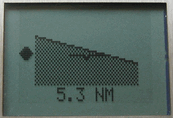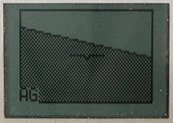
These pages describe some experimental “backup” avionics applications written to investigate what can be achieved using typical microcontroller hardware, in a battery-driven portable device that is not connected to the aeroplane in any way.
Although the programs described here run ‘on bare metal’, they could be implemented on any programmable device with the necessary sensors, such as smart phones, tablets, and other similar devices. The software is all written in C.
The prototype device shown here uses an off-the-shelf Olimex STM32-103STK » Starter Kit development board, which is available from Farnell and other suppliers. This is described on the Hardware page. I chose this device because:
- it uses very little power (it will run off the single AA battery visible in the picture for over nine hours)
- its LCD display is reflective – so it requires no backlight and is easily readable in full sunlight
- it has a useful set of peripherals, including accelerometers, and it is easy to add other sensors (e.g. the GPS module visible at the top of the device)
- it is small and portable.
I also looked at other devices; a promising one is the Primer2 » which has a nicer case (with plenty of room for a GPS module) and a higher resolution colour screen. However, the screen’s backlight uses significant power, and it is not as easily readable in sunlight (but if only used as backup that might not be an issue).
These devices are not expensive, in aviation terms. As of September 2010, the Olimex board is about £70 and the Primer2 about £50. The GPS module is about £30; cheaper ones are available. These prices are one-off retail, including taxes and delivery.
The various applications run as individual display layouts on the prototype hardware (similar to the ‘pages’ on typical hand-held GPS devices). The following are the primary applications (there are also some test applications). There is some discussion on these applications in the BMAA forum ».
Pilot assist
This application was built to experiment with aircraft attitude display derived from GPS information and accelerometers. Accelerometers cannot be used for deducing aircraft bank angle in the air because in a coordinated turn “down” is always at right angles to the wings; however, the attitude of the aircraft can be calculated from the rate of turn of the aircraft – and this can be determined from GPS readings.
GPS readings also have the advantage of being an external reference, so there is no dead-reckoning drift. There is necessarily a lag (delay) in calculating the bank angle; however, for just checking that the aircraft is flying straight with wings level this would not seem to be a major problem. It would be interesting to have an experienced instrument-rated pilot evaluate this.
The picture shown was taken in flight; in this case, accelerometer data is merged with the GPS-derived bank to show aircraft pitch and allow for any slip. Other GPS data (the ground speed, altitude, bearing, etc., shown in the larger picture above) could be added to the display for a miniature “glass cockpit”.
Track assist
This is an experimental and possibly novel application. It is intended to allow the use of a GPS device to guide one’s flight without the need to set waypoints in advance. This turns out to be especially useful when flying without a particular destination or flight plan in mind.
The application, once selected, notes the aircraft’s ground track and altitude. Once the pilot is happy with these, he or she presses a single button, and thereafter the application displays any deviation from that track and altitude.
Currently the deviation is shown on the display: in the picture shown, the display indicates that the desired track and altitude is 0.4 NM to the right and 50′ below. The current course is 218°.
Possible enhancements to this application would be:
- flash the red LED if the deviation exceeds various limits
- use the audio output capability of the device to give verbal warnings of deviation (into a suitable headset/intercom) – hence allowing the pilot to spend more time looking outside the aeroplane instead of at the instruments.
Since this photograph was taken, the bearing shown in the centre of the display has been changed to show the divergence/convergence angle compared to the desired track (i.e., showing 0° if flying parallel to the track).
Slip ball
This application is not of great practical use (a mechanical slip ball is unlikely to fail), and was written mostly just to confirm that it would work (it does). The slip ball graphic could be included in the Pilot assist display.
The picture to the right has the three accelerometer readings shown at the top, while the fourth line shows the current accelerometer maximum scale (the device can work to 2g or 6g) and smoothing (in this case, over 8 (23) readings). The slip ball graphic is at the bottom, which has a full-scale deflection of 10° and where the partial vertical lines indicate 5°.
GPS summary
This application displays a summary of the current GPS data. The lines on the screen show:
- the latitude (in degrees)
- the longitude (also in degrees)
- the altitude (in metres)
- the bearing reported by the GPS device, and the ground speed (in knots)
- the ‘dilution of position’, horizontal and vertical – this is an estimate of the accuracy of the GPS fix; in practice a dilution of 1.0 seems to correspond to about ten metres
- a status line
- the four characters on the left indicate the quality of results; AAA3 means all data are good
- the 09 indicates that 9 satellites were being received
- the 94457 is the time of day, UTC (09:44:57).
Backtrack assist
This application has not been tested in flight yet, but the screen shot demonstrates the principle. The intention is to meet the need for a scenario proposed by Kev Armstrong » in which a pilot accidentally flies into a cloud and wants to get back out as quickly and safely as possible. The idea is that the device records recent positions, and when the pilot presses the ‘Backtrack’ button (or starts the application) the device notes the position that the aircraft was at (say) 5 minutes previously, saves this as the target point, and from then on displays something like the pictured image. This has:- the bank angle (pseudo attitude) in the centre shown as an artificial horizon (the image also shows pitch information, from accelerometer)
- the direction to the target (in this image the target is to the left, indicated as a black diamond at about 9 o’clock – with a bigger screen one could do a nicer arrow, etc.)
- the distance to the target (so you’ll know that you should be out of the cloud when the target is straight ahead and close.
